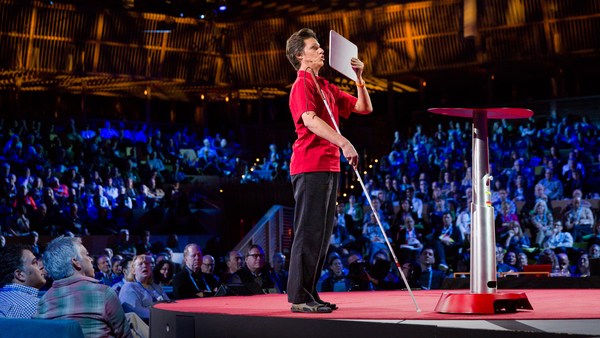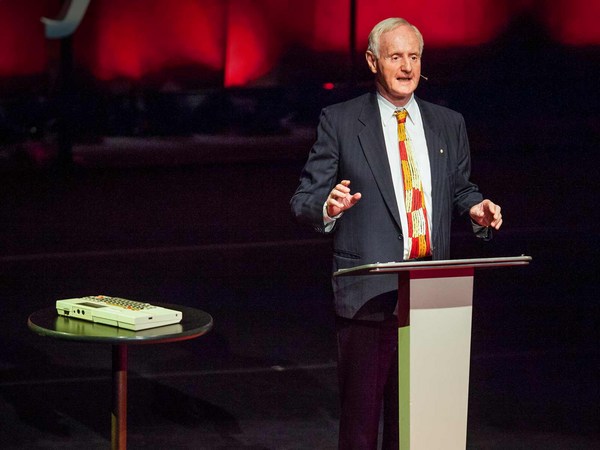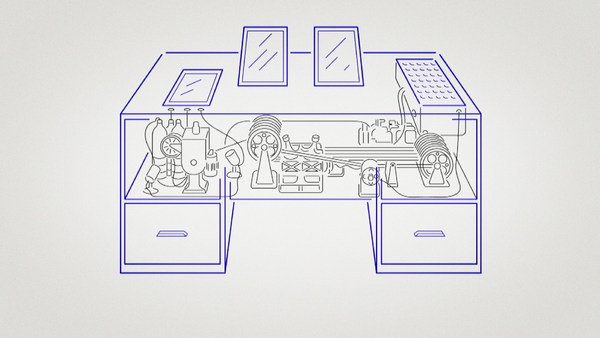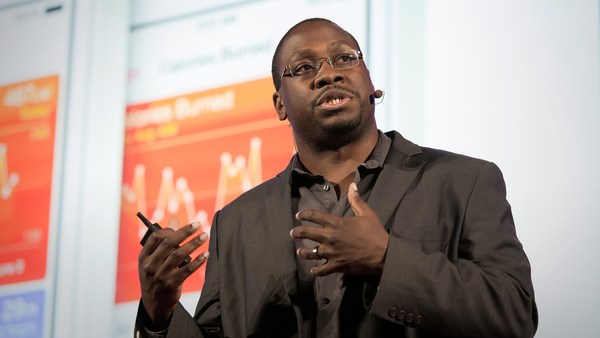You might think there are many things that I can't do because I cannot see. That's largely true. Actually, I just needed to have a bit of help to come up to the stage.
But there is also a lot that I can do. This is me rock climbing for the first time. Actually, I love sports and I can play many sports, like swimming, skiing, skating, scuba diving, running and so on. But there is one limitation: somebody needs to help me. I want to be independent.
I lost my sight at the age of 14 in a swimming pool accident. I was an active, independent teenager, and suddenly I became blind. The hardest thing for me was losing my independence. Things that until then seemed simple became almost impossible to do alone. For example, one of my challenges was textbooks. Back then, there were no personal computers, no Internet, no smartphones. So I had to ask one of my two brothers to read me textbooks, and I had to create my own books in Braille. Can you imagine? Of course, my brothers were not happy about it, and later, I noticed they were not there whenever I needed them. (Laughter) I think they tried to stay away from me. I don't blame them. I really wanted to be freed from relying on someone. That became my strong desire to ignite innovation.
Jump ahead to the mid-1980s. I got to know cutting-edge technologies and I thought to myself, how come there is no computer technology to create books in Braille? These amazing technologies must be able to also help people with limitations like myself. That's the moment my innovation journey began.
I started developing digital book technologies, such as a digital Braille editor, digital Braille dictionary and a digital Braille library network. Today, every student who is visually impaired can read textbooks, by using personal computers and mobile devices, in Braille or in voice. This may not surprise you, since everyone now has digital books in their tablets in 2015. But Braille went digital many years before digital books, already in the late 1980s, almost 30 years ago. Strong and specific needs of the blind people made this opportunity to create digital books way back then. And this is actually not the first time this happened, because history shows us accessibility ignites innovation. The telephone was invented while developing a communication tool for hearing impaired people. Some keyboards were also invented to help people with disabilities.
Now I'm going to give you another example from my own life. In the '90s, people around me started talking about the Internet and web browsing. I remember the first time I went on the web. I was astonished. I could access newspapers at any time and every day. I could even search for any information by myself. I desperately wanted to help the blind people have access to the Internet, and I found ways to render the web into synthesized voice, which dramatically simplified the user interface.
This led me to develop the Home Page Reader in 1997, first in Japanese and later, translated into 11 languages. When I developed the Home Page Reader, I got many comments from users. One that I strongly remember said, "For me, the Internet is a small window to the world."
It was a revolutionary moment for the blind. The cyber world became accessible, and this technology that we created for the blind has many uses, way beyond what I imagined. It can help drivers listen to their emails or it can help you listen to a recipe while cooking.
Today, I am more independent, but it is still not enough. For example, when I approached the stage just now, I needed assistance. My goal is to come up here independently. And not just here. My goal is to be able to travel and do things that are simple to you.
OK, now let me show you the latest technologies. This is a smartphone app that we are working on.
(Video) Electronic voice: 51 feet to the door, and keep straight.
EV: Take the two doors to go out. The door is on your right.
EV: Nick is approaching. Looks so happy. Chieko Asakawa: Hi, Nick!
(Laughter) CA: Where are you going? You look so happy.
Nick: Oh -- well, my paper just got accepted. CA: That's great! Congratulations.
Nick: Thanks. Wait -- how'd you know it was me, and that I look happy? (Chieko and Nick laugh)
Man: Hi. (Laughter) CA: Oh ... hi.
EV: He is not talking to you, but on his phone.
EV: Potato chips.
EV: Dark chocolate with almonds.
EV: You gained 5 pounds since yesterday; take apple instead of chocolate.
(Laughter)
EV: Approaching.
EV: You arrived.
CA: Now ...
(Applause)
Thank you.
So now the app navigates me by analyzing beacon signals and smartphone sensors and permits me to move around indoor and outdoor environments all by myself. But the computer vision part that showed who is approaching, in which mood -- we are still working on that part. And recognizing facial expressions is very important for me to be social.
So now the fusions of technologies are ready to help me see the real world. We call this cognitive assistance. It understands our surrounding world and whispers to me in voice or sends a vibration to my fingers. Cognitive assistance will augment missing or weakened abilities -- in other words, our five senses. This technology is only in an early stage, but eventually, I'll be able to find a classroom on campus, enjoy window shopping or find a nice restaurant while walking along a street. It will be amazing if I can find you on the street before you notice me. It will become my best buddy, and yours.
So, this really is a great challenge. It is a challenge that needs collaboration, which is why we are creating an open community to accelerate research activities. Just this morning, we announced the open-source fundamental technologies you just saw in the video.
The frontier is the real world. The blind community is exploring this technical frontier and the pathfinder. I hope to work with you to explore the new era, and the next time that I'm on this stage, through technology and innovation, I will be able to walk up here all by myself.
Thank you so much.
(Applause)





